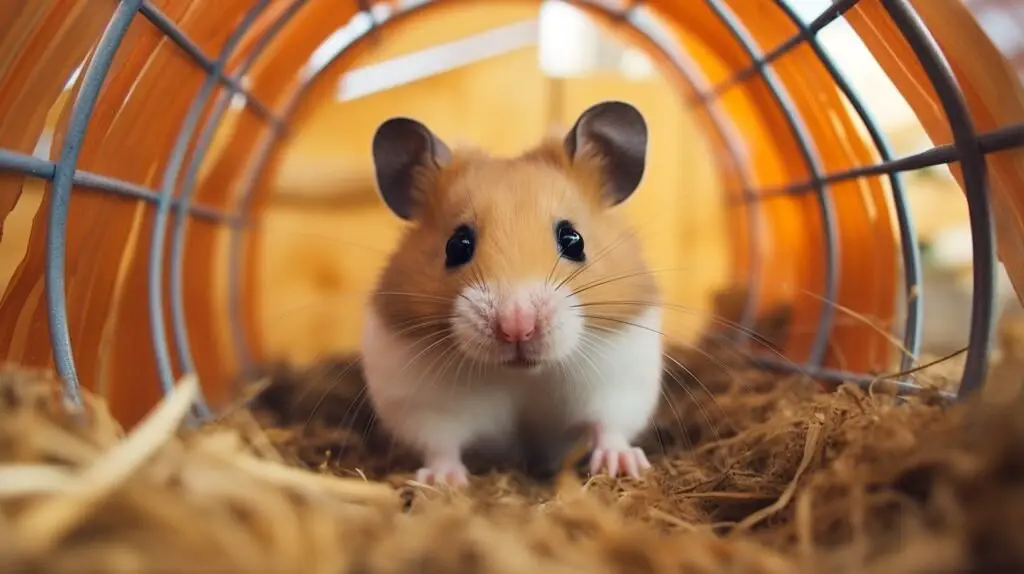Ah, the joys of summer – sunbeams casting a warm glow, and the sweet, hydrating crunch of watermelon slices. Ever caught your hamster eyeing your watermelon slice on a hot summer day? As a hamster enthusiast, I too, have pondered over whether our tiny furballs can partake in the watermelon joy. This article will quench your curiosity, diving into the nitty-gritty of feeding watermelon to hamsters.
Key Takeaways on Watermelon for Hamsters
Before diving into the details, here are the key points to remember:
- Hamsters can nibble on watermelon, but only a tiny bit as a rare treat.
- Overdoing it can lead to diarrhea or weight gain due to high sugar and water content.
- Deseed the slices, as the seeds are a choking hazard for our little friends.
- Introduce it slowly and keep an eye out for any tummy troubles.
- Fruits are just the cherry on top; the main course should be hamster pellets and grains.
- Mix it up with crunchy veggies and other fruits for a flavor fiesta.
Understanding Hamsters’ Dietary Needs

To understand if watermelon is suitable for hamsters, it helps to first look at their general dietary needs and preferences. In the wild, hamsters are omnivores, meaning they eat both plant and animal matter. Their natural diet consists of:
- Seeds and grains – These carbohydrate sources provide energy and fiber.
- Nuts – For protein and healthy fats.
- Vegetation – Grasses, shoots, and roots provide vitamins.
- Occasional insects – Essential protein source a few times per week.
- Fruits/Berries – Rare treats supplement nutrition when available.
This combination of seeds produce, and the occasional insect reflects their flexible opportunistic eating in the wild. They’ve evolved to make the most of available food sources based on season and terrain.
In captivity as pets, hamsters thrive on a diet that mirrors their omnivorous wild preferences. The ideal nutritional balance comprises:
- High-quality hamster pellets and grains as the dietary staples.
- Occasional protein-packed treats like mealworms or crickets.
- Small amounts of fresh produce like fruits and veggies to mimic wild foraging.
Understanding where fruits fit into the big picture diet-wise is key before offering watermelon. While hamsters enjoy sugary fruit as a supplemental treat, their main nutrition should come from pellets and hay. Let’s look at watermelon’s nutritional profile specifically.
Watermelon’s Nutritional Profile for Hamsters
Watermelon is made up of approximately 91% water, making it ideal for hydration on a hot day. But in addition to water content, watermelon provides the following nutritional value:
| Nutrient | Per 100g |
|---|---|
| Water | 91.5g |
| Carbs | 7.6g |
| Fiber | 0.4g |
| Fat | 0.15g |
| Protein | 0.61g |
| Vitamin C | 8% DV |
| Vitamin A | 11% DV |
| Potassium | 2% DV |
| Magnesium | 2% DV |
The vitamin, mineral, and antioxidant content makes watermelon potentially beneficial. Fiber aids digestion while vitamins support immune function. But there are downsides to the sugar and water content we must consider.
Potential Benefits of Watermelon for Hamsters
Before introducing any new food, it’s good to understand the possible benefits. In moderation, watermelon may offer hamsters:
- Hydration – The high water content can supplement their fluid intake, especially important in hot weather.
- Vitamin C – Watermelon contains this essential nutrient hamsters need for immune health.
- Fiber – The fruit’s fiber can encourage healthy digestion and bowel regulation.
- Treat variety – Small amounts add diversity to their diet and enrichment.
As with any fruit treat, the trick is providing just enough watermelon to get these advantages without going overboard. Too much can swing from benefit to risk.
Potential Risks of Feeding Hamsters Watermelon
While watermelon has its merits for hamsters, there are a few potential risks associated with over-feeding:
- High sugar content – Too much can lead to obesity, diabetes, and related issues over time. The natural sugar must be limited.
- High water content – Excessive watermelon may cause temporary diarrhea in some hamsters as their digestive system is overwhelmed.
- Seeds – The black seeds can pose a potential choking hazard for hamsters. Always seed the melon first.
- Lack of full nutritional balance – Watermelon on its own does not provide complete nutrition compared to a balanced hamster diet.
The risks mainly come down to monitoring portion sizes. Fed occasionally in tiny pieces, watermelon can be safe. But it should never contribute a large part of the weekly diet. Next we’ll look at exactly how much watermelon to feed.
Recommended Watermelon Portions for Hamsters

When introducing watermelon, start very small to assess tolerance:
- Initially offer just 1-2 small cubes – This “taster” amount allows you to check for diarrhea issues.
- Slowly work up to 2-3 cubes or thin slices twice per week – Increase slowly if the first portions pass through undigested.
- Feed no more than 1-2 times per week – Watermelon should be an infrequent treat, not a daily item due to sugar/water content.
- Aim for approximately 1 tablespoon of cubes per week – A few small cubes or wafer slices weekly are sufficient.
- Always chop watermelon into tiny, hamster-sized portions – Cut slices into minuscule cubes to prevent choking.
Monitor stool consistency when introducing watermelon and pull back if you notice diarrhea. Vary treats with other fruits/veggies for diversity.
Step-By-Step Guide to Feeding Watermelon Safely
Follow these steps when feeding watermelon to your hamster:
- Select a ripe, fresh watermelon – Avoid bruised or moldy spots.
- Thoroughly wash the rind under cold water – Remove any pesticides before cutting.
- Remove all seeds from the fruit – Seeds can cause intestinal blockage or choking. Discard seeds.
- Chop a small cube or slice into tiny pieces – Dime-sized or smaller to prevent choking.
- Introduce just 1-2 melon pieces at first – Monitor closely for diarrhea after trying new foods.
- Increase to 1-2 times per week if tolerated – Offer two cubes or a thin wafer a couple times a week maximum.
- Store any uneaten melon promptly in the fridge – Discard leftovers after 24 hours to prevent spoilage.
With safe preparation and controlled portions, your hamster can enjoy watermelon as an occasional snack! But it should never outweigh balanced nutrition sources like pellets.
Healthier Fruit and Veggie Alternatives for Hamsters
While hamsters can eat watermelon, there are even healthier fruit and vegetable options to provide treat variety including:
- Vegetables: Carrots, cucumbers, broccoli, sweet potato, peas
- Fruits: Apple, blueberries, strawberries, seedless grapes, banana
These provide prime nutrition with less risk of excess sugar. Vegetables are the healthiest choice due to higher vitamins, minerals and fiber with lower sugar.
Fruit should be no more than 10% of your hamster’s total food intake per week. Focus on variety and keep portions small. A few nibbles of different items keep their palate excited!
Frequently Asked Questions About Hamsters Eating Watermelon
Here are answers to some common questions about feeding watermelon to hamsters:
Can hamsters eat watermelon seeds?
No, watermelon seeds pose a serious choking hazard and can cause intestinal blockage. Always remove all seeds before feeding watermelon.
How much watermelon can I give my hamster?
Feed just 1-2 small cubes or slivers of watermelon 1-2 times per week at most. Fruits should be occasional treats, not daily foods.
Is watermelon juice safe for hamsters to drink?
No, avoid giving ham




